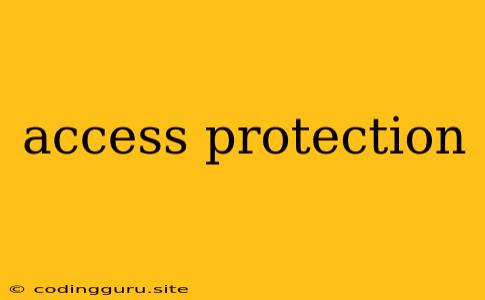Access Protection: Safeguarding Your Data and Systems
In today's digital landscape, where information is constantly flowing and systems are interconnected, access protection has become a paramount concern. It's the cornerstone of safeguarding your sensitive data and ensuring the integrity of your digital assets. But what exactly is access protection, and why is it so crucial?
Access protection encompasses a range of measures designed to restrict unauthorized access to your data, applications, and physical infrastructure. It aims to prevent malicious actors from exploiting vulnerabilities and compromising your valuable information. This includes controlling who can access what, when, and from where, effectively creating a robust security perimeter around your digital assets.
Why is Access Protection Essential?
Here's why access protection is critical for businesses and individuals alike:
- Preventing Data Breaches: The most significant threat to businesses today is the risk of data breaches. Access protection helps minimize this risk by limiting access to sensitive data to only authorized personnel.
- Protecting Intellectual Property: Businesses rely heavily on their intellectual property, including patents, trademarks, and trade secrets. Access protection ensures that these assets remain secure and confidential.
- Compliance with Regulations: Many industries have strict regulations governing data privacy and security. Access protection helps organizations meet these compliance requirements and avoid hefty penalties.
- Maintaining Business Continuity: A security breach can significantly disrupt business operations and cause financial losses. Access protection plays a crucial role in ensuring business continuity by minimizing the impact of such attacks.
Key Components of Access Protection
Access protection involves various components working together to create a comprehensive security framework. Here are some of the key elements:
1. Authentication: This is the process of verifying the identity of users attempting to access your systems. Common authentication methods include: * Password-based Authentication: This is the most widely used authentication method, but it's vulnerable to brute-force attacks. * Multi-Factor Authentication (MFA): This method adds an extra layer of security by requiring users to provide multiple forms of identification, such as a password and a one-time code sent to their phone. * Biometric Authentication: Using unique biological traits, like fingerprints or facial recognition, to verify identity.
2. Authorization: Once a user has been authenticated, authorization determines the level of access they have to specific resources. This could involve assigning different roles and permissions based on job function or security clearance.
3. Access Control Lists (ACLs): These lists specify the permissions granted to each user or group for specific resources, such as files, folders, or applications.
4. Encryption: This involves converting data into an unreadable format, making it inaccessible to unauthorized parties. Encryption is crucial for protecting sensitive data, such as financial records or customer information.
5. Network Security: Implementing firewalls, intrusion detection systems, and other security measures to protect your network from unauthorized access.
6. Physical Security: Securing physical access to your data centers, servers, and other critical infrastructure. This could include measures like surveillance cameras, security guards, and access control systems.
7. User Education and Training: It's essential to educate users about best practices for data security and to train them on how to identify and report potential security threats.
Tips for Implementing Access Protection
Here are some practical tips for effectively implementing access protection:
- Implement Strong Authentication: Use multi-factor authentication for all critical accounts and enforce strong password policies.
- Implement Least Privilege Access Control: Grant users only the permissions they need to perform their job functions.
- Regularly Review and Update Access Policies: Ensure your access control policies are up-to-date and reflect changes in your organization's security needs.
- Use Security Tools: Employ various security tools, such as firewalls, intrusion detection systems, and data loss prevention software, to enhance your access protection measures.
- Monitor for Suspicious Activity: Regularly monitor system logs and network traffic for any signs of unauthorized access or malicious activity.
- Stay Updated on Security Best Practices: Keep abreast of the latest security threats and vulnerabilities to ensure your access protection measures remain effective.
Examples of Access Protection in Action
Here are some real-world examples of how access protection is implemented:
- Banking: Banks use multi-factor authentication and encryption to secure online banking platforms and protect customer financial data.
- Healthcare: Hospitals and clinics employ strict access controls to protect patient medical records and ensure confidentiality.
- E-commerce: Online retailers utilize firewalls, encryption, and other security measures to protect customer credit card information and prevent fraud.
Conclusion
Access protection is an essential component of any comprehensive cybersecurity strategy. By implementing robust security measures, organizations can safeguard their data, protect their intellectual property, and maintain business continuity. It's crucial to stay vigilant and constantly adapt access protection strategies to counter evolving threats and keep your digital assets secure.
